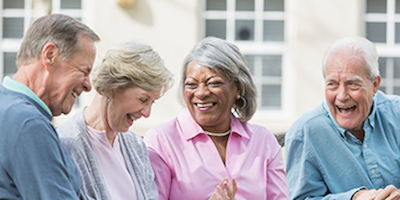By Julie Collins
Lillie lived to be 101 years old. She was fiercely independent. She made her own decisions and decided for herself when it was time to eat (when she was hungry), when it was time for bed (when she was sleepy), and how long she wanted to work on her word puzzles or her latest crocheting project. Lillie wanted no part of the structured assisted living facility her family provided for her. That lasted about three months before she announced that she was “done with that place.” She decided to live alone, with highly skilled caregivers who came each day to check on her, administer her medications, help her bathe and dress, and make sure that she had company and conversation when she wanted it. Lillie was my grandmother. Our family shared responsibility for caring for her across her doctor’s appointments, medications, and daily care. It is a daunting challenge to care for an aging adult. And we need a new policy approach to supplement our current government programs to address this challenge.
Families are facing this challenge because the American population is aging and living into their 80’s and sometimes 90s. According to 2019 data, about twenty-two million adults are seventy-five and older, about thirteen million Americans are eighty years old and older, and these people are primarily women. Data and reports from the Institute on Aging say that by 2050, the eighty-five-plus age group will reach nineteen million.
Living into the 70’s, 80’s and 90’s comes with new realities. Declining health is a core component of their daily lives, including difficulty with activities of daily living (ADLs). Older people may need help with basic activities such as dressing and eating. Due to declining health, they may fall easily, and can experience hearing loss. While their bodies may be declining, many times, their spirits remain strong, and many aging adults retain their strong will to continue to participate in daily activities.
Care provided by family and friends can help older adults remain at home. Older women are twice as likely as older men to live alone. Living arrangements also differ by race and ethnicity. Older non-Hispanic White women and Black women are more likely than women of other races to live alone. Sixty-five percent of older adults with long-term care needs rely exclusively on family and friends to provide assistance. Women still far outnumber men as the primary caregivers for their families, with more than seventy-five percent of caregivers being women.
It takes money and resources to care for an aging family member effectively. About thirty percent supplement care provided by family members with paid assistance, an option that helps bridge gaps in skill sets from family members to provide medical knowledge and care. Private, out-of-pocket care is the easiest to access but is often the most expensive. These services are staffed with highly qualified and trained professionals who can administer medications, accompany the person to medical appointments, manage nutrition, and support older adults with personal needs. Social services can also provide some relief. Medicare and Medicaid also provide medical care, prescription medications, and home health assistance, but qualifying and activating these resources requires a labyrinth of paperwork and follow-ups and the benefits are usually insufficient to provide the full range of necessary care. Some doctors are providing telehealth options, but my family’s experience was that the technology and ability to use it effectively varied widely from office to office. A key thing to know about caring for elderly people is that they need human contact and voices to check in on them. Even a quick phone call a few times a week gives them a sense of connection and care. This contact stimulates their days and gives them the energy to keep going. This is especially important when bridging geographic distances.
So, how do we address this aging population’s critical needs? How do we create a support system for our elderly citizens, many at their most vulnerable, as we continue to navigate through a global health crisis? How do we activate resources when they are needed? How do we protect the parents and grandparents we love to support and care for them through the last phase of their lives? I recommend a new Protect Our Parents policy to supplement the current Medicare and Medicaid system.
This new Protect Our Parents Policy would provide for a safety net for our aging citizens with an ecosystem of medical care and personal care that is supplemental to the current Medicare and Medicaid programs. This care would be easily accessible, with simple qualification processes that families can understand and complete. Ongoing management and evaluation would also provide high-quality and safe care. Each citizen would be assigned their case manager to work with the families to frame the best solution for their family member. This ecosystem would be housed in a newly created technology-based system with sophisticated algorithms that automate the access and caregiving process, and support the manual human capabilities with proactive information and notifications. There is an analog for this approach with the work that Dr. Paul Farmer led with Partners In America. In their community based experiences, Dr. Farmer’s team would travel to the patients to make sure that they were taking their medicines and had enough food to sustain their treatment regimens. This new approach could be funded out of the current Medicare/Medicaid budget through both a reallocation and an efficiency process. Currently, the most current Centers for Medicare and Medicaid Services (CMS) report data shows that in 2022 Medicare spending grew 3.5% to $829.5 billion and Medicaid spending grew 9.2% to $671.2 billion. There should be sufficient funding available out of these budgets.
The choices families face in caring for aging family members will continue to be challenging. Like so many other families, our family did everything we could to keep Lillie healthy through her life. She passed peacefully, cared for through her very last breath. How do we create this peaceful transition for our mothers, fathers, grandmothers, and grandfathers? Gandhi said, “The true measure of any society can be found in how it treats its most vulnerable members.” Aging and death are human realities. We must protect and support everyone’s Mom and Dad so that they can maintain their independence, health, and dignity each day of their remaining days.

Julie is a second year EMPA student at NYU Wagner. She is a purpose driven leader focused on health equity and community service initiatives. Julie developed the proprietary “Launch, Learn, Pivot” process to get new thinking out quickly and continually optimize. Julie lives in New York in West Chelsea.




